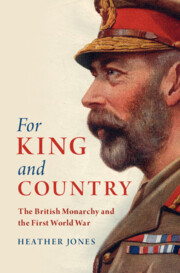Refine search
Actions for selected content:
15401 results in Military history
Bibliography
-
- Book:
- For King and Country
- Published online:
- 09 September 2021
- Print publication:
- 23 September 2021, pp 495-541
-
- Chapter
- Export citation
Contents
-
- Book:
- For King and Country
- Published online:
- 09 September 2021
- Print publication:
- 23 September 2021, pp v-v
-
- Chapter
- Export citation
Part III - The Unknown Soldier
-
- Book:
- For King and Country
- Published online:
- 09 September 2021
- Print publication:
- 23 September 2021, pp 323-404
-
- Chapter
- Export citation
4 - De-Sacralisation Discourses
- from Part II - The Emperor’s New Clothes
-
- Book:
- For King and Country
- Published online:
- 09 September 2021
- Print publication:
- 23 September 2021, pp 245-322
-
- Chapter
- Export citation
5 - The Monarchy and the Armistice
- from Part III - The Unknown Soldier
-
- Book:
- For King and Country
- Published online:
- 09 September 2021
- Print publication:
- 23 September 2021, pp 325-360
-
- Chapter
- Export citation
Introduction
-
- Book:
- For King and Country
- Published online:
- 09 September 2021
- Print publication:
- 23 September 2021, pp 1-19
-
- Chapter
- Export citation
Index
-
- Book:
- For King and Country
- Published online:
- 09 September 2021
- Print publication:
- 23 September 2021, pp 542-576
-
- Chapter
- Export citation
6 - The Monarchy’s Role in Sacralising Post-War Commemoration
- from Part III - The Unknown Soldier
-
- Book:
- For King and Country
- Published online:
- 09 September 2021
- Print publication:
- 23 September 2021, pp 361-404
-
- Chapter
- Export citation
Figures
-
- Book:
- For King and Country
- Published online:
- 09 September 2021
- Print publication:
- 23 September 2021, pp vi-viii
-
- Chapter
- Export citation
Table
-
- Book:
- For King and Country
- Published online:
- 09 September 2021
- Print publication:
- 23 September 2021, pp ix-ix
-
- Chapter
- Export citation

For King and Country
- The British Monarchy and the First World War
-
- Published online:
- 09 September 2021
- Print publication:
- 23 September 2021
3 - Small Wars and Domain Theory
-
- Book:
- The New Art of War
- Published online:
- 12 August 2021
- Print publication:
- 02 September 2021, pp 149-192
-
- Chapter
- Export citation
Index
-
- Book:
- The New Art of War
- Published online:
- 12 August 2021
- Print publication:
- 02 September 2021, pp 437-446
-
- Chapter
- Export citation
Acknowledgments
-
- Book:
- The New Art of War
- Published online:
- 12 August 2021
- Print publication:
- 02 September 2021, pp xxiii-xxiv
-
- Chapter
- Export citation
Conclusion
-
- Book:
- The New Art of War
- Published online:
- 12 August 2021
- Print publication:
- 02 September 2021, pp 368-372
-
- Chapter
- Export citation
Bibliography
-
- Book:
- The New Art of War
- Published online:
- 12 August 2021
- Print publication:
- 02 September 2021, pp 425-436
-
- Chapter
- Export citation
2 - The Masters of War Theory and Strategy
-
- Book:
- The New Art of War
- Published online:
- 12 August 2021
- Print publication:
- 02 September 2021, pp 52-148
-
- Chapter
- Export citation
4 - The Unified War Theory
-
- Book:
- The New Art of War
- Published online:
- 12 August 2021
- Print publication:
- 02 September 2021, pp 193-308
-
- Chapter
- Export citation
Figures
-
- Book:
- The New Art of War
- Published online:
- 12 August 2021
- Print publication:
- 02 September 2021, pp viii-x
-
- Chapter
- Export citation
Preface
-
- Book:
- The New Art of War
- Published online:
- 12 August 2021
- Print publication:
- 02 September 2021, pp xi-xxii
-
- Chapter
- Export citation
